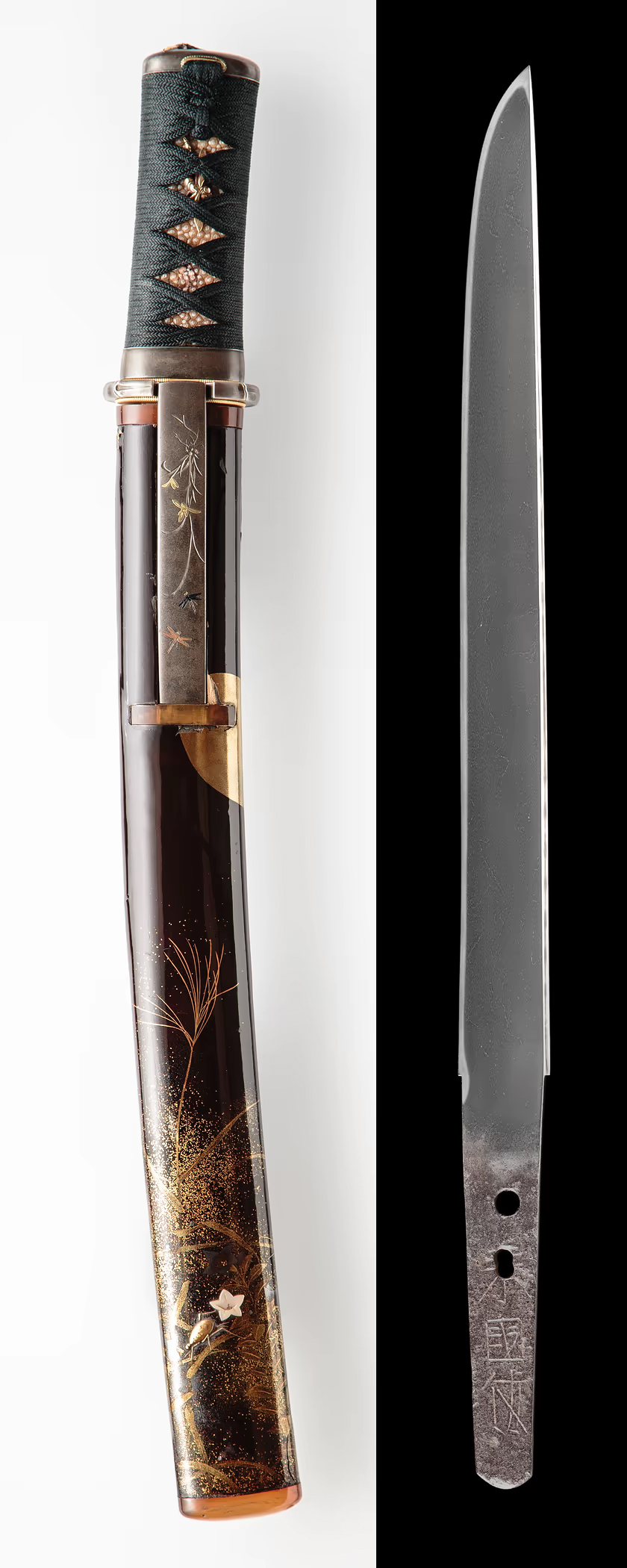Description
The Yamashiro Rai school was founded in legend by a smith named Kuniyoshi, who is considered to have come from Korea. The character Rai 来 means come,
and the implication is that this relates to the founder coming from overseas to Japan. There are no extant works by Rai Kuniyoshi though, so in practical terms the founder of Rai is considered to be Rai Kuniyuki. His style is purely mid Kamakura, making majestic broad blades with dense choji hamon.
The son of Rai Kuniyuki is the smith referred to as Niji Kunitoshi (i.e. two-character Kunitoshi
). Signed work by this smith is generally in the style of his father, utilizing choji in the hamon and with the wide blade and ikubi kissaki of the times. There is some confusion because following Niji Kunitoshi is the smith referred to as Rai Kunitoshi. The work of Rai Kunitoshi in contrast is more elegant and less flamboyant, often featuring suguba and a tapering sugata. When his signature is found, it takes the form of three characters reading 来國俊 (Rai Kunitoshi). He can alternately be called Sanji Kunitoshi (three character Kunitoshi).
Luckily for us, there is a dated work of 1315 by Rai Kunitoshi where he placed his age of 75 years on the nakago. Homma sensei, the founder of the NBTHK and renowned expert on Nihonto, wrote this about Rai Kunitoshi in Great Masterpieces of Japanese Art Swords:
[In regards to the dated work at 75 years of age] … Together with the date inscription, this is an important reference material for the study of Rai works. Of those signed works by Rai Kunitoshi which have been examined to date, the earliest is dated Sho-o 3-nen (at the age of fifty), and [the latest is] Genkyo Gan-nen (at the age of eighty-one).
Fifty years of age would seem to be unusually late for a smith of grandmaster skill to appear on the scene. There is dated work by Niji Kunitoshi, a famous one with the date of 1278, and one with the date of 1286. There is no other dated work by Niji Kunitoshi that I am aware of, and if we are to believe that these works are by Rai Kunitoshi at the beginning of his career then this would make him 38 and 46 years old at their time of production, which would allow him decades of experience to accumulate the skill he displays under the old signature style.
Fujishiro has weighed in on the one smith / two smith theory as well, writing:
The theory that two kanji Kunitoshi and Rai Kunitoshi were separate persons is a theory that ignores the style changes of the times (See Nagamitsu). In the Showa Gonen Book section of the Kanchiin Hon, beneath a Kunitoshi two kanji signature nakago, it says, “Rai Magotaro Nyudo, kogiri yasuri, becomes wide sugu yakiba”, and this is a record which coincides with the time when Kunitoshi and Kunimitsu nado were living. What became clear in later years was that it was discovered that his works covered a long period of time, due to works inscribed with Showa Yonen Nanajugosai (Showa 4, 75 years of age) and Bunpo Gannen Seinen nanajuhachi (Bunpo 1 age 78). Also, the two character Kunitoshi period coincides with the prime of his life, and backs up the one generation theory.
Furthermore, he indicates that Rai Kunitoshi is one of the smiths who was famous in his own time. He writes:
It is not hard to imagine why the kaji Kunitoshi, Kunimitsu, and father and son Kunitsugu were famous and prospered in their time. Among the names of the swordsmiths that have been handed down to the present day, there are two cases, the one in which their fame was circulated about while they were still living, and those which became famous after they died. It is probably reasonable to consider Kunitoshi nado among the former.
Rai Kunitoshi has long been considered to be one of the top three tanto makers of all time, and stands with Awataguchi Yoshimitsu and Shintogo Kunimitsu in this elite club. The form of his tanto are considered to have achieved perfection and are the archetype used to describle late Kamakura tanto work.
The Students of Rai Kunitoshi
Rai Kunitoshi had many fine students, and as Fujishiro wrote he was famous in his own time in the capital city Kyoto. These students made works called daisaku and daimei which were works made in substitution for the teacher, and works made by the teacher but signed by the student on his behalf. There is some disagreement on what these terms mean, but I will quote Kokan Nagayama who is authoritative:
Daimei: When a swordsmith’s signature is chiseled onto a sword by his son or student with his permission, this signature is called a daimei (“substitute signature”) and regarded as equivalent to the real signature. it seems that students also often produced swords in their teacher’s or father’s style, with full permission. Production of this sword is known as daisaku (“substitute production”), and such blades were often signed by the teacher rather than the student. These signatures are also regarded as authentic.The Connoisseur’s Book of Japanese Swords
So a daimei, substitute signature, is work of the teacher which has been subsequently signed on his behalf by one of his students. Daisaku is work of the student, which bears the teacher’s name, with his permission. In the case of daisaku, the teacher may have signed the blade himself or the student may have put the teacher’s signature on the blade with his teacher’s permission. Sometimes the term daisaku-daimei is used for this type of blade, where everything is done by the student, substituting for the teacher.
Manufacture of a Japanese sword is a team effort in the best of cases. The master smith directs the hammer work of his best students who have not yet graduated into making their own blades independently. Preparation work in the forge, cutting charcoal for instance, is done by students lower on the learning curve. The master swordsmith is equivalent to a general and directs the actions of his team in fabricating a sword. Everything is performed to his specification, under his training. Students are on a path to taking on responsibility for independently fabricating things. One of the stages of this, they are instructed in inscribing signatures, and finally of course they will be given instruction in fabrication and eventually will have their own hammer-men and students which they will direct themselves in making their own swords.
The major workshops such as Osafune Nagamitsu’s in the late Kamakura period had many master smiths working under Nagamitsu’s tutelage. Nagamitsu’s workshop had the following master smiths that we know of: Sanenaga, Kagemitsu, Chikakage, Norimitsu, Kagemasa, Nagamoto, Mitsukane, Moritada, and Morishige. The most skilled of these smiths were Kagemitsu, Sanenaga and Chikakage and Kagemitsu went on to head the workshop with the passing of Nagamitsu. As one can imagine some of these smiths were older and more senior to the others, and over time would graduate and make swords on their own in the workshop, bearing their own signatures. But the presence of all of these master smiths allowed Nagamitsu to be very efficient in the manufacture of blades.
Daisaku and daimei blades are one means of this efficiency. When a senior student is close to working on his own in charge of a group of junior smiths, he may be called upon to make daimei which basically will free up time for the master smith to continue fabricating blades. This also trains the soon-to-graduate pupil in signature craftsmanship and gives the teacher a chance to observe, correct, and guide his signing actions. Daimei are usually works that will be seen in the twilight of the teacher’s life, when he is no longer healthy enough to continue working in the shop but as long as he lives he is considered the leader and head smith. If the students are sufficiently advanced, they will be able to produce swords independently but under his guidance, and the final product inspected and authorized to bear his signature. During this time the students will likely also be independent and able to sign their own names to blades. The best of the students will be granted one character or possibly the full name of the master smith. In this way we see the lineage of smiths passing down a character of their name. For example: MITSUtada to NagaMITSU to KageMITSU to KaneMITSU to MasaMITSU.
The Six Signature Styles of Rai Kunitoshi
Rai Kunitoshi’s shop was also a major center of sword fabrication, and he had many master smiths working under his guidance. These students were Rai Kunimitsu, Rai Kuninaga, Rai Kunitsugu, Rai Kunizane, Rai Kunisue, Rai Mitsukane, Rai Tomokuni, and Ryokai. Interestingly enough, Rai Mitsukane was one of the students of Nagamitsu as well, but moved to Kyoto and joined Rai Kunitoshi’s workshop.
This is of consequence because when we examine all of the signatures of Rai Kunitoshi we see two important things. The first is that Kunitoshi’s signature evolves in obvious and subtle ways. The obvious case is that he adds the character Rai (来) to his signature sometime between the ages of 38 and 48. Secondly we see the construction of the Kuni (国) character evolving over time. Below, I have attempted to sketch out the evolution. The general habit though is that he uses a flat, continuous stroke through the upper middle of the Rai character. The Kuni has four slightly up-tilted horizontal strokes.
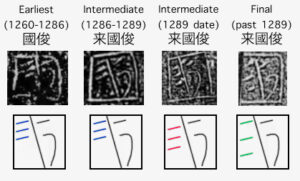
- The leftmost early work is from the two character “Niji Kunitoshi” signature style that lacks the Rai character. For this reason we know it is earliest.
- The second panel is from a tachi with a Rai Kunitoshi 3 character “Sanji” signature. This Kuni character completely matches the old style of the Niji Kunitoshi signatures. Because of this it must be an early transitional signature, where he followed the pattern of his old signature but has just added the Rai above it. As such I place this between the 1286 last dated work of Niji Kunitoshi and before the 1289 dated Rai Kunitoshi work in the third panel, which is showing some drift in the horizontal strokes in the kuni, shown in red.
- The third panel is from a tanto with a 1289 date. This is the earliest dated work of Rai Kunitoshi. Since we know he is 75 years old in 1315, this work was made when he was 49 years old.
- Later work appears to continue this drift as the horizontal strokes spread (shown in green) to cover the available space in the Kuni character, so I place this as the last and final form of the style of his writing.
Besides these three major forms of signature in Rai Kunitoshi works, we see three other distinct styles. In each of these, the Rai character emulates the strokes of the master signature group, but the Kuni character is very different. In each of these three cases there is a direct correspondence in the Kuni character to the signatures of Rai Kunimitsu, Rai Kuninaga, and Rai Kunitsugu. The theory then is that these three other signature patterns represent daimei blades, with the individual differences in the Kuni character reflecting the student tasked with placing the signature into the blade (as kind of a code, or signature-within-a-signature). Each of these students seems to have taken pains to make his own signature distinct from the other students by making specific stroke angles on the various short strokes in the characters of his name. This follows through to their construction of the Rai character when signing for themselves, but not when signing for the master.
The following contains my research as not much information is given in major texts about daimei blades. Fujishiro makes some attempt to classify the daimei of Kunitsugu and Kunimitsu in the following statement:
The `Rai’ and `Kuni’ of Kunitoshi, Kunimitsu and Kunitsugu are recognizably different, as in the plate to the left. The `Kuni’ kanji of Kunimitsu and Kunitsugu are almost the same, but as for Kunitoshi, in those with the Shōwa nengo, there are the kanji in which it is in between the `Kuni’ of Kunimitsu and Kunitsugu. As for his final year of Gen’ō, it is a `Kuni’ like that of Kunimitsu. Also […] there is one in which the `Kuni’ looks like that of Kunitsugu. I also think it is a daimei of Kunimitsu nado.
I think he is not correct speculating that Kunimitsu made daimei in the style of Kunitsugu’s signature, and he did not see any that were in the style of Rai Kuninaga so missed one category of signature . So I will pick up where Fujishiro leaves off as I think these daimei were made specifically with the signature differences as a code indicating which student made the signature.
Rai Kunimitsu Daimei
Rai has up-tilted strokes through the upper middle instead of straight.
Kuni has four steeply up-tilted horizontal strokes (more so than the master signature group).
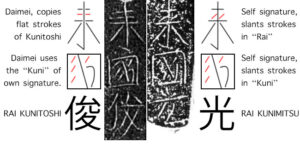
Rai Kuninaga Daimei
Rai has two flat strokes through the upper middle.
Kuni has four flat horizontal strokes.
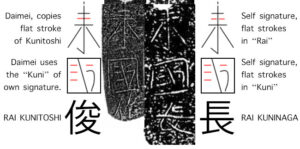
Proposed Rai Kunitsugu Daimei
Rai has two flat strokes through the upper middle.
Kuni has four down-tilted horizontal strokes.
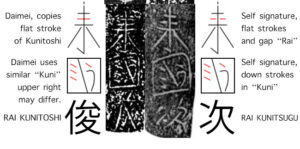
Analysis
When these Rai smiths make daimei, they seem to abandon their own version of the Rai character and use Kunitoshi’s, and then they make sure to use their own Kuni. There is actually a sixth version of Kuni (2 from Kunitoshi himself, 3 from these students, plus the last one). This last version seems to me to be Rai Kunitsugu again as it shares three of the four down-tilted horizontal strokes, and otherwise appears to be his hand at work. The fourth stroke is up-tilted as per the master signature group. It is possible that this is a fourth student making daimei, such as Ryokai or one of the others, but for now I have just grouped this pattern with Rai Kunitsugu.
I have performed this analysis only by looking over clear signatures from oshigata I have access to. I don’t otherwise believe that Rai Kunitoshi would be making six different signatures for himself, and the variations correspond too well with the signatures of the students I think for another suitable explanation, as well as following this simple and clear “coding” pattern which makes it possible to ascertain which student was given the task of finishing the work in each case.


Hozon Rai Kunitoshi Tanto
In the case of this tanto, I believe it to be one of the daimei works that falls into the pattern of signatures made by Rai Kuninaga on Rai Kunitoshi works. The level of craftsmanship is extremely high on this tanto, and is equal to the Rai Kunitoshi Juyo Token blades that I have had before. Usually when given the blade for examination, people have answered that it is a tanto by Shintogo Kunimitsu who challenges for one of the finest smiths of all time.
There is another interesting hallmark on the blade, where it bears a single gunome at the machi. This is often found on Awataguchi Kuniyoshi, and Shintogo Kunimitsu, as well as Rai Kunitoshi.
Similar to Yoshimitsu and Shintogo, this blade is thickly covered with ji nie and exhibits strong nie utsuri. The hamon is nearly hoso suguba and shows great skill, as it includes fine nie down to the ha along with very fine sunagashi and kinsuji. It is a beautiful and elegant tanto.
In looking over the Juyo signatures, I found that about half of them were daimei as above. The greatest number of daimei to be from Rai Kunimitsu and Rai Kuninaga equally, which is a bit of a surprise because Rai Kunitsugu is usually held to be higher ranking than Rai Kuninaga. However, Rai Kuntsugu’s are infrequently found compared to the other two. If this were the case in terms of how the teacher organized his workshop, then I would think his treatment and so the resulting blades handed down today would show his daimei being found in larger quantities. It is possible that his were randomly destroyed more frequently, but with enough surviving blades that becomes a difficult theory to accept. In some old books Rai Kunitsugu is listed as a son of Rai Kunimitsu and generally his work looks more like Nanbokucho where Rai Kunimitsu’s work looks older, more associated with Kamakura. So this could be the case either that he was a son of Kunimitsu and perhaps a late student of Rai Kunitoshi and this is why we see his daimei appear much more infrequently. As well the number of daimei blades appear to represent about 50% of the existing work of Rai Kunitoshi.
All of these in my analysis above have been confirmed as work of Rai Kunitoshi by the NBTHK and are at least Juyo Token (with the exception of one Hozon blade, the blade discussed here). Furthermore some of them are included among the Tokubetsu Juyo works, so they indicate no drop off of skill (and in fact represent the highest skill) of Rai Kunitoshi. As Rai Kunitoshi had the highest skill level of all the Rai Smiths it would seem to indicate that these are indeed daimei blades rather than daisaku as any student working on his own would not be able to replicate Rai Kunitoshi’s skill. A full chart of how I have sorted out the signatures based on what oshigata I have access to is included below.
This tanto too has been confirmed by the NBTHK as work of Rai Kunitoshi. There is a rarely issued opinion of to mei ga aru that applies sometimes on very old blades. It indicates that the signature is accepted but but the NBTHK thinks it is unusual and an area for research (which I’ve attempted to provide). The NBTHK does not paper blades with false signatures. These will fail shinsa and are returned to the owner who must then remove the signature and submit it again for papers. Blades with this notation do pass Juyo and Tokubetsu Juyo.
To understand the context, I am including a set of examples from the NBTHK where to mei ga aru has applied to the item. In these cases they are signed blades attributed to Norishige (Juyo Token), Ko-Hoki Yasutsuna (Juyo Token), and Awataguchi Kuniyoshi (Tokubetsu Juyo Token). These are all makers of the absolutely highest skill, equal or higher even than Rai Kunitoshi, and papered at top levels.
Here is commentary on the Norishige:
This tantō shows a standing-out and large-structured itame mixed with mokume and nagare. There is plentiful ji-nie and here and there thick chikei, which means the hada appears altogether as matsukawa-hada. The hamon is based on notare and is mixed with ko-notare, gunome, with many kinsuji and sunagashi, plenty of hotsure along the habuchi, a kind of yubashiri-based nijūba, and some tobiyaki. The nioiguchi is wide and quite nie-laden and we recognize the typical hand of Norishige. The deki is excellent and as for the tantō-sugata, the fukura is scarce and there is a hint of uchizori what results in a takenokozori (another characteristic feature of Norishige). We know various signature styles of Norishige but the one seen on this tantō is not yet known. This in turn means that we have here a future research topic.
Goto Mitsumasa
Goto Mitsumasa was the second son of Goto Benjo, and a nephew of Goto Ichijo. He became the head master of the Hanzaemon branch of the Goto family with Benjo’s passing (lineage to the right courtesy of Markus Sesko’s excellent book The Japanese tōsō-kinkō Schools). He worked in the mid 1800s and became one of the students of Goto Ichijo from whom he developed his style working in shibuichi.
Goto Ichijo is likely one of the top three soft metal artisans of Japanese history, and certainly of the late Edo period. He shook the moribund style of the Goto main line out of its stasis and introduced new styles and materials which established his place in history as an innovator. Ichijo took commissions from the Emperor and was a house artist for the Tokugawa shogun. His artistic sense in my opinion is second to none, and his works never cease to amaze. Ichijo had many extremely skilled students who are considered among the grand masters of the time, indicating his own prowess as a teacher and his fame in his time as he attracted talented men to his circle.
Goto Ichijo began working in shibuichi, an alloy of silver and copper, after mastering the shakudo and gold house style of Goto. He reached the peak of his skill in this material, which carried forward into his use of iron which followed. Shibuichi makes a beautiful background material as in high grades it contains subtle texture, and provides good contrast for silver, gold and shakudo inlay, as well as good contrast for carvings.
At the time of manufacture of this kozuka, the main Shirobei line of the Goto family had come to an end with the death of the 16th master Hojo. There was some contention for the mastership of this house with this vacancy, and it was (according to Mosle) contended by Goto Mitsumasa, Goto Mitsuhira and Goto Mitsunori. Mitsuhira is also documented as having changed his name to Mitsunori later on, and he is the one who emerged as the 17th head of the main line (though this was not universally supported apparently). It does, however, point to the skill level of these artists that they would contend for the head of the main and most distinguished line of the Goto family.
This kozuka is signed by Goto Mitsumasa and shows his connection to Goto Ichijo, made in shibuichi and featuring gold and shakudo inlays of flowers and dragonflies. It is a beautiful piece of art on its own. The shibuichi has been carefully forged and features crystals of higher concentrated silver in the matrix. When patinated these crystals resist more than the surrounding alloy and the result is a beautiful texture in the ground displaying the crystalline structure. This kozuka is papered NBTHK Hozon, authenticating the signature of Mitsumasa.
The koshirae that houses the tanto and kozuka are also gorgeous. They are from the late Edo period and done in gold maki-e, continuing the theme of insects and reeds from the kozuka. Flowers are inlaid with mother of pearl on which the play of light compliments the maki-e. The fuchi, tsuba and kashira are in shibuichi with gold as well but are by a different hand from Goto Mitsumasa, the papers cover only the kozuka. The menuki are gold wasps.
This lacquerware also continues the theme of insects in the kodogu, with charming little beetles standing out on the surface of the koshirae. As an antique that was used, many koshirae show signs of wear and tear, and this piece is not an exception as there are some cracks and abrasions. These are not detrimental as they are signs of original condition, but it may be a valid option for the new owner to undertake some minor restoration work. It would not be expensive, but it is perfectly valid to leave this as is as it is an antique and as mentioned, something used and treasured by a past owner
Makiie
Making gold maki-e lacquerware is very difficult and time consuming. This art involves shaving a gold block with a specialized tool that makes small gold flakes of a unique shape which catches and reflects light beautifully. Japanese lacquer is very durable and protects against the elements, and the item to take this treatment is first lacquered with many layers forming a base coat and women’s hair is used for the best brushes for this application. This is slowly cured and aged. Then, the design is painted in place with very fine brushes made from mouse hair, and then gold flakes are sprinkled into the artwork, adhering where the lacquer was placed down. This is then lacquered over and the process repeated. The result of this difficult and time consuming art is a uniquely three dimensional kaleidoscope of gold flakes which embedded in the lacquer, which scintillates in the light as the item or the viewer moves.

